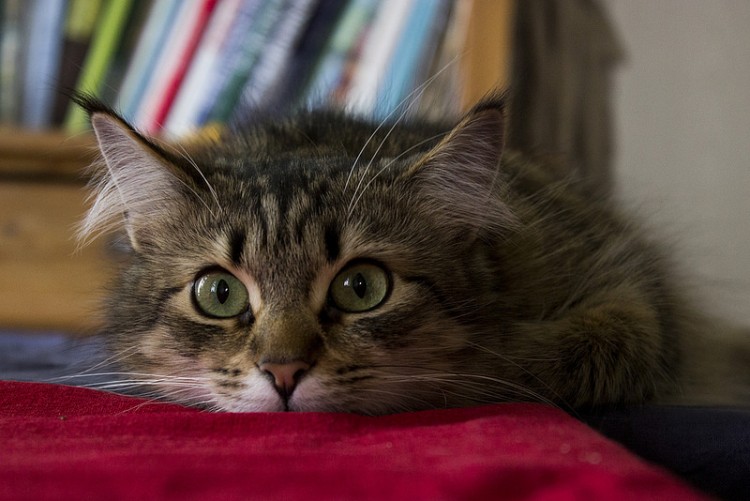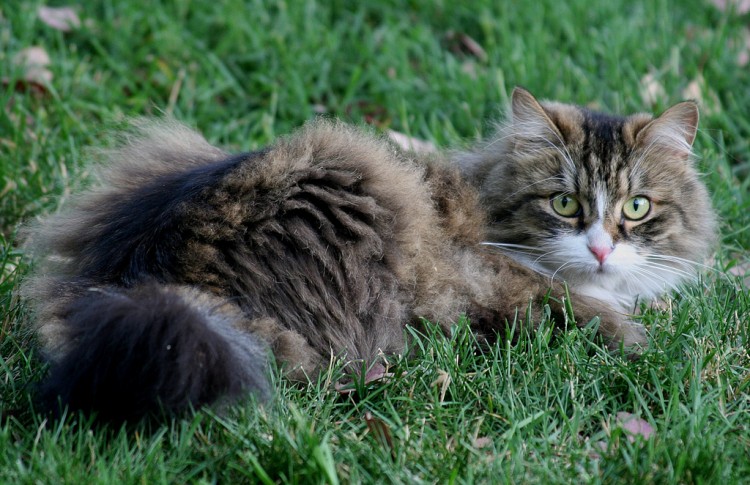
1. Key Characteristics
- Height: 13 inches
- Weight: 10–20 pounds, with some males weighing up to 25 pounds
- Life expectancy: Around 15 years
Siberians are medium to large muscular cats originating from Russia.
Their eyes are mostly round and can be any color, though some Siberians have blue eyes or one eye of a different color.
Their ears appear pointed because of extra hair found in and around the ears, but the edges are rounded and may have Lynx tipping.
According to Kate Conley, author of Siberian Cats, the “ears and toes may have tufts, or a bunch of small hairs. These hairs would have protected its ancestors from harsh weather.”
The tail is bushy and usually carried high off the back. The triple coat is water-repellent and features medium to long hair, depending on the season.
Any color or pattern is possible, including pointed coats.
2. Where They Came From
The earliest known reference to Siberian cats was recorded in the year 1000, according to the International Cat Association.
The cats started appearing in conformation shows in the 1870s and were referenced at Madison Square Garden in 1884. After that, several books mentioned the breed, including:
- Harrison Weir’s Our Cats (1889)
- John Jennings’s Domestic & Fancy Cats (1898)
- Helen Winslow’s Concerning Cats (1900)
The first breed standard was written and published by the Kotofei Cat Club in Moscow. After the Cold War ended, the cats were exported to America. The first 3 Siberians were imported in 1990 by Elizabeth Terrell.
The first 3 colorpointed Siberians arrived in 1997, when Dana Osborn imported a male and female, and the next year the cats produced the first colorpoint litter in America.
The Siberian cat breed was first registered with the International Cat Association (TICA) in 1992 and later by the Cat Fanciers’ Association (CFA) in 2000.
TICA awarded the breed championship status in 1996, and the CFA awarded the same recognition in 2006.

3. How Friendly Are They?
Siberians are fearless, quiet, playful and calm.
They can take up to 5 years to fully mature but remain playful throughout their lives.
These cats love to be close to family members and get along great with children, dogs, cats and other animals. They are more likely to chirp or trill than meow.
They are also creative ad intelligent — Siberians are problem solvers.
They also exhibit dog-like behavior. They will greet people at the door, come when called and enjoy playing fetch.
Was YOUR Pet Food Recalled?
Check Now: Blue Buffalo • Science Diet • Purina • Wellness • 4health • Canine Carry Outs • Friskies • Taste of the Wild • See 200+ more brands…

4. Is This the Right Cat for You?
Exercise Needs
MEDIUM: Siberians are playful, athletic and active cats with a lot of energy. Their hind legs are longer than the front to give them impressive jumping power in their acrobatic movements and high leaps.
Keep your Siberian cat indoors — their calm and fearless nature may render them unable to judge threats effectively. Plus you run the risk of someone stealing them.
Grooming Needs
LOW: Siberians like to play in water — start bathing your cat as a kitten so she can acclimate to bathing.
The coat doesn’t tangle easily, so occasional brushing is all you need to do for most of the year (a few times per week).
Your cat’s coat will be thick and dense in the winter but will shed to a shorter, thinner coat in the summer. Increase brushing during this molting period to daily.
Because of the extra hair in the ears, you’ll want to clean them regularly (a good habit to get into, along with trimming the nails).
Although Siberians are touted as hypoallergenic cats, this has not been proven. However, they do produce a low amount of dander, so this may be a good fit for people with allergies.
Health Problems
LOW: Your Siberian is susceptible to all of the usual feline health problems, but there is one genetic condition that this breed tends to carry — hypertrophic cardiomyopathy, a condition in which the heart muscle thickens.
This Siberian loves to retrieve the ball again and again and again and again…

5. Where to Adopt One
I was able to find 8 Siberian cats throughout the United States, and 3 were purebred.
Although this breed is not commonly found, it’s still a good idea to check with your local shelters or rescues in case they might have one who needs a home.
If you contact a breeder, be aware that kitten mills do exist. Always view the breeder’s facility and other cats and kittens to ensure they are receiving proper care.
Also, ask the breeder about screening results for hypertrophic cardiomyopathy. A simple echocardiogram can confirm if the condition is present.


